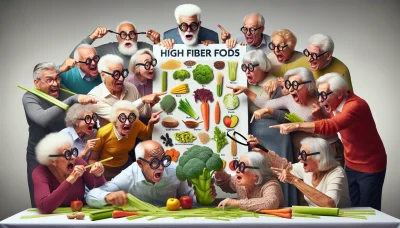Low carb anti inflammatory diet Quiz
Test Your Knowledge
Question of
Understanding the Low Carb Anti-Inflammatory Diet
Basics of a Low Carb Anti-Inflammatory Lifestyle
Defining Low Carb: What It Means for Inflammation. A low carb diet focuses on minimizing carbohydrates to reduce inflammation in the body. This approach emphasizes consuming whole, unprocessed foods rich in nutrients while avoiding sugar and refined grains. By reducing carb intake, the body's inflammatory response can significantly decrease, leading to improved overall health.
The Role of Anti-Inflammatory Foods. Anti-inflammatory foods play a pivotal role in this diet. These include leafy greens, fatty fish rich in Omega-3s, nuts, and seeds. Incorporating these foods into your diet not only helps reduce inflammation but also supports heart health and enhances immune function. The key is to consume a variety of these nutrient-dense foods regularly.
Balancing Macronutrients for Optimal Health. Achieving a balance among fats, proteins, and carbohydrates is crucial. A low carb anti-inflammatory diet suggests a higher intake of healthy fats and proteins while keeping carbohydrate consumption low. This balance supports sustained energy levels, weight management, and reduced inflammation.
Scientific Evidence Supporting the Diet
Research on Inflammation and Carbohydrate Intake. Numerous studies have demonstrated a link between high carbohydrate intake and increased inflammation. Diets high in sugar and refined carbs can lead to elevated blood sugar levels, contributing to chronic inflammation. Conversely, reducing carbohydrate intake has been shown to lower inflammatory markers in the body.
Studies on Diet and Chronic Disease Prevention. Research indicates that a low carb anti-inflammatory diet may play a significant role in preventing chronic diseases such as heart disease, diabetes, and Alzheimer's. By focusing on anti-inflammatory foods and reducing carbohydrate intake, individuals can lower their risk of these conditions.
Long-Term Health Outcomes of Low Carb Diets. Long-term adherence to a low carb anti-inflammatory diet has been associated with numerous health benefits. These include improved cardiovascular health, weight loss, enhanced cognitive function, and reduced risk of chronic diseases. It's clear that making this dietary change can have profound effects on overall well-being.
Tips for Successfully Implementing a Low Carb Anti-Inflammatory Diet:
- Avoid processed foods and sugars to reduce inflammation effectively.
- Incorporate a variety of anti-inflammatory foods into your meals daily.
- Maintain a balanced intake of macronutrients by focusing on healthy fats and proteins while limiting carbs.
- Stay hydrated and consider supplementing with Omega-3s if you're not consuming enough fatty fish.
- Plan meals ahead to ensure you're sticking to your dietary goals and avoiding temptations.
Essential Foods for Your Anti-Inflammatory Meal Plan
Embarking on an anti-inflammatory meal plan is a game-changer for your health, energy levels, and overall well-being. It's about choosing foods that work for you, not against you. This journey is not just about eating; it's about thriving. Let's dive into the top anti-inflammatory food choices that will revolutionize your diet and how you feel every day.
Understanding which foods to embrace and which to avoid can dramatically alter your body's inflammatory response. It's a powerful step toward managing pain, reducing the risk of chronic diseases, and boosting your mood and energy levels. Lets get started on this transformative path together!
Top Anti-Inflammatory Food Choices
Leafy Greens and Their Nutritional Impact
Leafy greens are superheroes in the world of nutrition! Packed with vitamins, minerals, and antioxidants, they're your best allies in fighting inflammation. From spinach to kale, these greens reduce oxidative stress in your body, setting you on a path to optimal health. Make them a staple in your diet to experience their incredible benefits.
Including a variety of leafy greens in your meals ensures you're getting a broad spectrum of nutrients. Each type brings its unique set of health-boosting properties to the table. Embrace this diversity for a well-rounded approach to combating inflammation.
Healthy Fats: Sources and Benefits
Healthy fats are essential in an anti-inflammatory diet. Foods rich in omega-3 fatty acids, like salmon, avocados, and nuts, play a crucial role in reducing inflammation throughout the body. They support heart health, improve brain function, and enhance overall well-being.
Incorporating these healthy fats into your meals not only fights inflammation but also adds delicious flavors and textures to your dishes. It's a win-win situation where you enjoy great food while doing something fantastic for your health.
Quality Proteins: Building Blocks for Health
Quality proteins are non-negotiable when it comes to building and maintaining a healthy body. Lean meats, fish, legumes, and tofu provide essential amino acids that help repair tissues and reduce inflammation. They're the building blocks for a strong, resilient body.
Aiming for variety in your protein sources ensures that you receive all necessary nutrients while keeping meals exciting and flavorful. This approach supports muscle health, aids recovery, and contributes significantly to reducing bodily inflammation.
Foods to Avoid on a Low Carb Diet
Common Inflammatory Food Triggers
Certain foods act as common triggers for inflammation and should be limited or avoided altogether. Processed foods, sugary treats, and refined grains can wreak havoc on your body's inflammatory response. Recognizing these culprits is the first step towards eliminating unnecessary inflammation from your life.
- Avoid processed meats like sausages and deli slices which are high in preservatives.
- Cut down on sugary beverages including sodas and fruit juices that spike blood sugar levels.
- Limit intake of refined carbohydrates such as white bread and pastries which can fuel inflammation.
- Steer clear from trans fats found in fried foods and certain margarines known for their inflammatory effects.
- Moderate alcohol consumption as excessive drinking can lead to systemic inflammation.
High Carb Foods That Can Sabotage Your Goals
Beware of high-carb foods! While they might offer temporary satisfaction or comfort, they can seriously derail your anti-inflammatory goals. Foods like pasta, white rice, and sugary snacks contribute to blood sugar spikes leading to increased inflammation.
Understanding Food Labels and Hidden Carbs
Navigating food labels is crucial in identifying hidden carbs that could be sabotaging your efforts towards an anti-inflammatory lifestyle. Learning to spot terms like "dextrose," "maltose," or "syrup" helps you make informed decisions about what goes into your shopping cartand ultimately into your body.
Meal Planning and Preparation Tips
Embarking on a low carb lifestyle requires thoughtful planning and preparation. It's not just about cutting carbs; it's about embracing a balanced, nutritious approach to eating. Meal planning is your secret weapon for staying on track, ensuring you have delicious and healthy meals throughout the week without the last-minute stress.
Preparation is key to success. By dedicating a few hours each week to prepare your meals, you can save time, reduce waste, and eliminate the temptation of unhealthy convenience foods. Let's dive into how you can create a weekly low carb meal plan that's both satisfying and simple to follow.
Creating a Weekly Low Carb Meal Plan
Structuring Your Meals for Balance and Variety
To achieve balance and variety in your low carb meal plan, start by including a wide range of vegetables, lean proteins, and healthy fats in each meal. This ensures not only a low carb intake but also a rich supply of nutrients essential for optimal health. Variety is crucial to prevent boredom and maintain enthusiasm for your healthy lifestyle.
Time-Saving Tips for Meal Prep
Meal prep doesn't have to be daunting. Begin with simple steps such as chopping vegetables ahead of time or cooking proteins in bulk. Utilize kitchen gadgets like slow cookers or pressure cookers to make the process even smoother. Remember, the goal is to make your week easier, so find strategies that work best for you.
Portion Control and Macronutrient Distribution
Understanding portion control and macronutrient distribution is vital in a low carb diet. Aim to fill half your plate with non-starchy vegetables, one quarter with lean protein, and the remaining quarter with healthy fats. This simple visual guide helps ensure you're getting the right balance of nutrients at each meal.
- Plan your meals around seasonal produce: Not only is it cost-effective, but it also adds natural variety to your diet throughout the year.
- Batch cook: Prepare large quantities of staple foods like proteins or soups at once, then divide them into portion-sized containers for the week.
- Use a shopping list: Stick to your list based on your meal plan to avoid impulse buys that may not fit into your low carb diet.
- Incorporate leftovers creatively: Repurpose leftovers into new meals to save time and reduce food waste.
Cooking Techniques for Maximum Nutrition
Methods to Preserve Nutrients in Food
Cooking methods can significantly impact the nutritional content of food. Techniques such as steaming or poaching preserve vitamins and minerals better than high-temperature methods like frying. Additionally, using minimal water when cooking vegetables can reduce nutrient loss.
Flavorful Low Carb Cooking Without Added Sugars
A common misconception is that low carb meals are bland or uninteresting. However, by leveraging herbs, spices, and natural flavor enhancers like lemon juice or vinegar, you can create deeply flavorful dishes without relying on added sugars or high-carb ingredients.
Anti-Inflammatory Herbs and Spices to Enhance Your Dishes
Incorporating anti-inflammatory herbs and spices such as turmeric, ginger, cinnamon, and garlic not only boosts flavor but also offers health benefits. These powerful ingredients can help reduce inflammation in the body while adding depth to your low carb dishes.
Managing Health Conditions with a Low Carb Diet
Impact on Metabolic Syndrome and Diabetes
Blood Sugar Regulation Through Diet: A low carb diet is a powerful tool for managing blood sugar levels. By significantly reducing carbohydrate intake, these diets can help stabilize blood sugar fluctuations, offering a steadier energy source and reducing the risk of diabetes-related complications. This approach has been shown to improve glycemic control in individuals with type 2 diabetes.
Insulin Sensitivity and Carbohydrate Restriction: Carbohydrate restriction enhances insulin sensitivity. When you cut down on carbs, your body's need for insulin decreases, which can be particularly beneficial for people with insulin resistance or prediabetes. Studies have demonstrated that low carb diets can lead to weight loss and improved insulin sensitivity.
The Role of a Low Carb Diet in Diabetes Management: Adopting a low carb diet can be a game-changer in diabetes management. It not only helps in controlling blood glucose levels but also addresses other risk factors such as obesity and high blood pressure. Many individuals have been able to reduce or even eliminate their dependence on diabetes medication through dietary changes alone.
Benefits for Autoimmune and Inflammatory Conditions
Dietary Strategies for Autoimmune Disorders: Low carb diets may offer relief from autoimmune disorders by reducing inflammation and modulating the immune system's response. By eliminating grains, sugars, and other high-carb foods, which can trigger inflammatory responses, sufferers of conditions like rheumatoid arthritis may experience a decrease in symptoms.
The Connection Between Gut Health and Inflammation: The health of our gut plays a crucial role in inflammation and autoimmune diseases. A low carb diet promotes gut health by fostering a balanced microbiome, potentially alleviating autoimmune symptoms by reducing gut permeability and systemic inflammation.
Success Stories: Personal Journeys on the Diet: Countless individuals have turned their lives around by adopting a low carb lifestyle to manage their autoimmune conditions. These personal success stories highlight the transformative power of dietary changes in improving quality of life, reducing disease symptoms, and in some cases, leading to remission.
- Avoid processed foods: Opt for whole, unprocessed foods to maximize nutrient intake and minimize harmful additives.
- Maintain hydration: Drinking adequate water is crucial when following a low carb diet to support metabolic processes and prevent constipation.
- Incorporate healthy fats: Healthy fats are essential on a low carb diet, providing energy and supporting cell function without spiking blood sugar.
- Eat plenty of non-starchy vegetables: Vegetables are rich in nutrients and fiber while being low in carbs, making them ideal for maintaining overall health.
- Moderate protein intake: Ensure an adequate protein intake to support muscle maintenance without overconsumption which could impact ketosis if you're following a ketogenic approach.
- Avoid hidden carbs: Be vigilant about hidden carbs in sauces, dressings, and packaged foods to stay within your daily carbohydrate limit.
Integrating Exercise with Your Diet for Optimal Results
Best Practices for Physical Activity on a Low Carb Diet
When you're embarking on a low carb diet, adapting your exercise regimen is critical. Initially, you might experience reduced energy levels as your body adjusts to using fat for fuel instead of carbohydrates. It's essential to start slow, perhaps with low to moderate intensity exercises, and gradually increase the intensity as your body adapts.
Understanding how your body uses energy during exercise on a low carb diet is crucial. As you enter ketosis, your body becomes more efficient at burning fat for energy, which can eventually lead to improved endurance and performance. However, this transition doesn't happen overnight, so patience and persistence are key.
Hydration and maintaining electrolyte balance are paramount for individuals following a low carb diet and engaging in physical activity. Since a low carb lifestyle can lead to increased fluid and mineral loss, it's important to replenish these through proper hydration and by consuming electrolyte-rich foods or supplements.
Adapting Your Exercise Regimen to a Low Carb Lifestyle
To maximize the benefits of a low carb diet while staying active, consider incorporating a mix of aerobic and anaerobic exercises into your routine. Aerobic exercises like walking or cycling help improve cardiovascular health without overly depleting glycogen stores. In contrast, resistance training supports muscle growth and maintenance, crucial for an efficient metabolism.
Understanding energy use and ketosis during exercise helps in fine-tuning your workout strategy. Initially, workouts may feel more challenging as your body adjusts to using fats for fuel. Over time, however, many individuals report enhanced endurance and performance, underscoring the importance of consistency and adaptation in your exercise approach.
Understanding Energy Use and Ketosis During Exercise
When you limit carbs in your diet, your body shifts towards burning fats for energy through a process called ketosis. This metabolic state can significantly impact your exercise performance and endurance. Initially, you might experience a dip in energy levels during physical activities as your body adapts to this new fuel source.
To optimize energy use during ketosis, focus on activities that primarily rely on fat for energy, such as steady-state cardio or moderate-intensity training. This allows you to leverage the metabolic benefits of ketosis without overtaxing your glycogen-depleted muscles.
Hydration and Electrolyte Balance for Active Individuals
- Maintain Hydration: Active individuals need more fluids than the average person. Aim for at least 8-10 glasses of water per day, increasing intake before, during, and after workouts.
- Increase Electrolytes: Sweating depletes not just water but also key electrolytes like sodium, potassium, and magnesium. Replenish these with electrolyte-infused drinks or natural sources like bananas and avocados.
- Avoid Dehydration Cues: Don't wait until you're thirsty to drink water; thirst is already a sign of dehydration. Keep water handy and sip regularly throughout the day.
- Beware of Overhydration: Drinking too much water can dilute your body's sodium levels (hyponatremia), leading to potential health issues. Balance is key; listen to your body's signals.
Anti-Inflammatory Exercises to Complement Your Diet
Low-Impact Workouts for Joint Health
Incorporating low-impact workouts into your routine can significantly benefit joint health while still promoting weight loss and cardiovascular fitness. Activities such as swimming, cycling, or using an elliptical machine provide excellent cardiovascular workouts with minimal stress on the joints.
Strength Training to Reduce Inflammation
Strength training not only builds muscle mass but also helps reduce inflammation in the body when done correctly. Focus on moderate weights and higher repetitions rather than pushing heavy loads which can strain joints and muscles unnecessarily.
Flexibility and Mobility Routines
Including flexibility and mobility exercises in your workout regimen is essential for maintaining joint health and preventing injuries. Practices such as yoga or Pilates offer tremendous benefits by enhancing flexibility, improving posture, reducing stress levels, and supporting overall well-being.
Overcoming Challenges and Staying Motivated
Dealing with Common Obstacles in Diet Transition
Transitioning to a new diet can often feel like navigating a minefield of challenges. One of the foremost hurdles is dealing with the inevitable cravings for old favorites, while concurrently adjusting your palate to enjoy healthier options. It's a journey that requires patience, resilience, and a solid strategy.
Navigating Social Situations and Dining Out can be particularly tricky when you're trying to stick to a new eating plan. The key is preparation and confidence. Before attending social gatherings or dining out, research the menu ahead of time and don't hesitate to ask for customizations. Remember, your dietary choices are for your health, so own them proudly.
Managing Cravings and Comfort Eating Habits is another common obstacle. To combat this, have healthy alternatives on hand that satisfy similar textures or flavors you're craving. Also, understanding the emotional triggers behind comfort eating can help in finding other ways to cope, such as through exercise or hobbies.
Adjusting to the Initial Phases of the Diet Change often involves physical and psychological challenges. Your body may initially resist the change, leading to symptoms like fatigue or irritability. It's crucial during this phase to stay hydrated, get enough sleep, and remind yourself why you started this journey.
Strategies for Long-Term Success on the Diet
Setting Realistic Goals and Tracking Progress are foundational steps for long-term success. Start with achievable goals that lead to small wins, keeping you motivated. Tracking progress isnt just about stepping on a scale; it's also about acknowledging changes in energy levels, mood, and overall well-being.
- Mistake: Setting overly ambitious goals that lead to disappointment.
- Mistake: Not tracking progress in ways other than weight loss.
- Mistake: Ignoring the importance of non-scale victories.
- Mistake: Overlooking the benefits of a support network.
Building a Supportive Community or Network can significantly impact your diet transition journey. Whether it's friends who share similar health goals or online communities where you can exchange recipes and encouragement, having support makes the journey less daunting and more enjoyable.
Celebrating Milestones and Non-Scale Victories is absolutely essential. Whether its fitting into an old pair of jeans or noticing an improvement in your skin complexioncelebrate these moments! These victories provide tangible proof of your hard work and are excellent motivators to keep pushing forward.
Advanced Topics in Low Carb Anti-Inflammatory Eating
Intermittent Fasting and Its Synergy with Low Carb Diets
Understanding the Basics of Intermittent Fasting
Intermittent fasting is a revolutionary approach to eating that cycles between periods of fasting and eating. It's not just about what you eat, but when you eat. This method has been linked to numerous health benefits, including weight loss, improved metabolic health, and even extending lifespan. The beauty of intermittent fasting lies in its simplicity and flexibility, making it easily adaptable to any lifestyle.
Combining Fasting with Low Carb for Enhanced Benefits
Merging intermittent fasting with a low carb diet creates a powerhouse duo for combating inflammation and shedding pounds. This combination amplifies the body's ability to enter ketosis, thereby enhancing fat burning and reducing inflammation. The low carb intake during eating periods supports sustained energy levels and prevents spikes in blood sugar, seamlessly complementing the fasting periods.
Personalizing Your Fasting Schedule for Your Lifestyle
There's no one-size-fits-all when it comes to intermittent fasting schedules. Whether it's the 16/8 method, where you fast for 16 hours and eat during an 8-hour window, or alternate-day fasting, the key is finding a rhythm that fits seamlessly into your life. Listen to your body and adjust accordingly. Success with intermittent fasting comes from consistency and adaptability.
The Role of Supplements in an Anti-Inflammatory Diet
Identifying Key Nutrients and Their Sources
An anti-inflammatory diet focuses on whole foods rich in nutrients that fight inflammation. Omega-3 fatty acids found in fish, antioxidants present in berries, and polyphenols in green tea are just a few examples. However, it can be challenging to get all necessary nutrients from food alone, which is where supplements come into play.
Supplementing Wisely: When and What to Consider
Selecting the right supplements can elevate your anti-inflammatory diet to new heights. But beware; not all supplements are created equal! Focus on high-quality sources of omega-3s, curcumin (from turmeric), magnesium, and vitamin D. These are critical for maintaining optimal health and combating inflammation.
Interactions Between Supplements and Medications
The interaction between supplements and medications can't be overlooked; they can either diminish or enhance the effect of medications. For instance, omega-3 supplements might interact with blood-thinning medications, increasing bleeding risk. Always inform your healthcare provider about any supplements you're taking to avoid adverse interactions.












